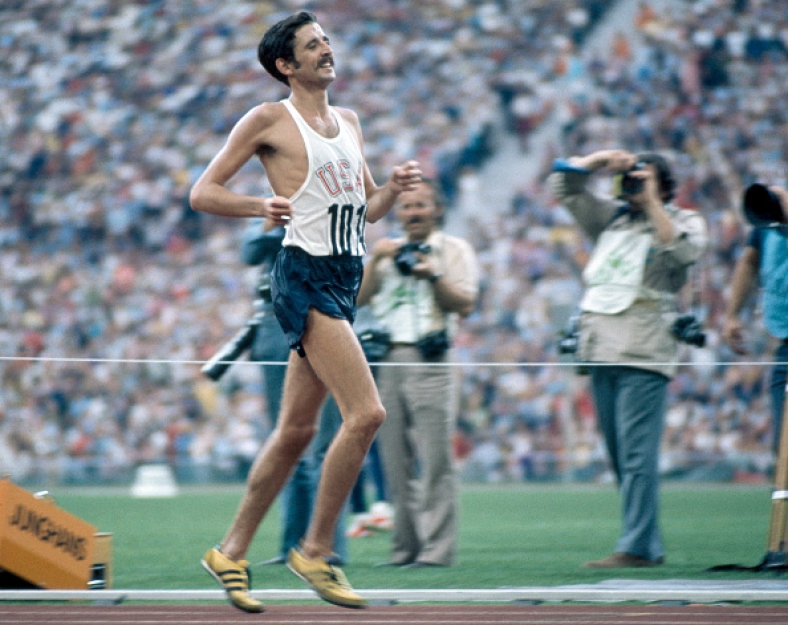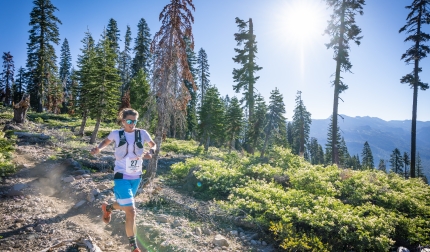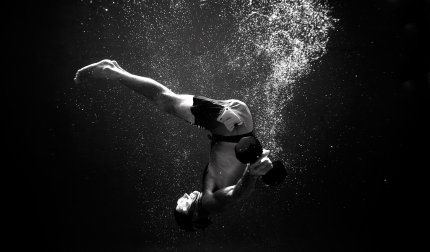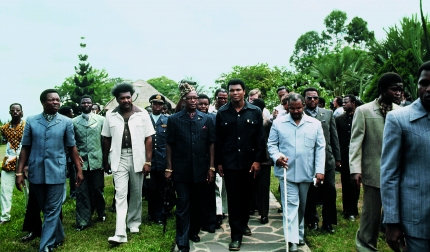Most people know Frank Shorter as a legendary marathoner and US Olympic gold medalist who helped inspire America’s running boom in the 1970s. But in his new book, My Marathon: Reflections on a Gold Medal Life, Shorter reveals that his achievements as an athlete and an Ivy League-educated lawyer were built atop a childhood devastated by a physically abusive father.

Joe Pugliese/August
Why did you decide to write this book?
The most important part of it for me was for kids or other adults who have suffered abuse to know that you can emerge from it. You can find a way through it. The kids in my family, we were all alone; there was no help. It doesn’t matter what your socioeconomic status is, it happens at all levels. As a child, when I was five, I was in the midst of getting thrashed, and it dawned on me that nothing that I ever did deserved this. Once I was able to understand that, I started to look for a way out. The way out essentially became running as a way to relieve stress. I would also always look for mentors and good people. I developed a certain way of thinking and dealing with things that carried on not only with my running, but with any other activity in which I became involved.
In the book, you recall speaking at a public event a few years ago where you revealed your childhood experiences. It didn’t sound like you planned to reveal them.
My father had been dead for a few years. When this happens to you as a child, you are always very fearful. That adult can still instill fear. I was in Springfield at a place called Boys and Girls Town with [marathoners] Bill Rodgers and Dick Beardsley. I just looked out and saw those kids, and said, “Some of us are part of the same veterans’ organization.” The idea of the event was for them to hear from all of these successful adults, and in my instance, an Olympic gold medalist. I wanted to let them know where I came from. I was an example that you can emerge from where you are here. One little girl came up afterward and said, “That’s me. That was my family.” She was the sibling that tried to protect the others and couldn’t, and she felt guilty. It’s survivor’s guilt. It’s not just you being abused, it’s all your siblings. I wasn’t thinking about the outcome of what I had said; it was just time to talk.
What happened after that day?
John Brant, the writer who collaborated with me on the book, was sent from Runners World to do a “what’s he doing now” story? Among other things, I mentioned the abuse and my involvement in Healthy Learning Paths, a curriculum for all school kids that not only deals with health and exercise, but there is also a mental health component now too. After the original article appeared in Runners World, for four years that was sort of it. I never wanted it to appear that I was talking about this was in any way for my own self aggrandizement or promotion. I didn’t want to appear like some aging Hollywood star looking to jumpstart a career and get their face back out there. But I did think that sometimes we want to know how things come about. For me, I had to physically and mentally escape the abuse, and that meant going out the door and running.
So for you, running was a way to get away from your father?
That’s how it all started. The primary reason I was doing it, was to be safe, because when I was out there, he couldn’t get me. But it was also about how to mentally deal with the situation. Thoughts would come to me while I was outside, because it was my safe place. The message is that everyone has his or her own safe place. Dealing with it can help set you up for success. I thought that telling the story and how I got through it might help other people who are going through it to get something out of it. But also people who aren’t going through it can realize how serious it can be and help create safe places for these kids, like that little girl in Springfield.
How did your running career evolve?
I was very unusual as an athlete in that I was my own coach once I graduated from college. I went to Yale, because coach Bob Giegengack was the Olympic track coach. He coached in a way that taught an athlete how to coach himself. My coach felt I had a chance to make the Olympic team, so after college, I dropped out of med school to see if I could make it. I went to law school while I trained so that I would have a backup.

What made you choose the marathon? It wasn’t nearly as popular as it is today.
It was a way to the Olympics, but you’re correct that it didn’t have the notoriety or recognition that it does now. In my two Olympics, 1972 and 1976, the race wasn’t even on the last day. Now, it may be the premier symbolic event, because it’s on the day of the closing ceremonies. I wanted to figure out how good I could be and how far I could go both academically and athletically. I didn’t want to leave running until I felt like I got as far as I could. With ongoing success, I was able to keep training and see where I would level off, and I just didn’t (laughs). But I realized that the longer the races were, the better I was. I had never thought about running the marathon until Kenny Moore, who had run the marathon for the US team in 1968, suggested that I run the trial marathon for the Pan American Games in 1967. I was going to law school full time and was running 10 miles a day. We ran that Pan Am trials race and I made the team in the marathon and the 10,000 meters as well.
It seems that you brought a unique strategy to the marathon.
I treated it like laps in a track race. Each five kilometer segment was a lap for me. I was visualizing myself doling out my effort over the course of the race. I won at the Pan American Games. Then I ran in the Fukuoka marathon in Japan the following fall and won that. It all happened very quickly. It wasn’t that I chose the marathon. I was trying to find how much success I could have as a runner. I was ranked second in the world in the 10,000 meters, but the marathon became the event. It’s not that I’m in love with the distance, that’s for sure! (laughs) I hope that everyone that tries to run a marathon can get to 22 miles. At that point, your body starts to run out of glycogen—that’s what they call “the wall.” There is a satisfaction in working through that feeling and emerging from it, being able to mentally keep your body going, knowing that there is going to be an end, and it will be over. There’s a certain survival aspect to it.
In 1972, you qualified for the Olympics, and then there was an unspeakable tragedy when eleven Israeli athletes and coaches were held hostage and eventually killed. What was going through your mind while this was happening?
Whenever I would leave my house, either to run or go to school or to my friends’ houses, where it was normal, I was able to turn on my “outside the house” switch and turn off the “home” switch. When the tragedy happened, we all thought we were going home. Everyone in our room, about eight of us, we all thought the Olympics were over. Nothing is worth human life. Not one person said, “How could they do this to us?” in terms of the selfishness that the opportunity of the Games might be taken away. It was really this wonderful moment where you all realize what’s most important. We went through all the stages: the shock, the depression, the emergence and then, finally, the defiance. We had two or three days to go through all the stages. When we found out the Games were going to go on, by that time, we were in the defiance stage. Some people take years to go through this.
After the memorial service, I’m walking back to the room with Kenny Moore, and he said, “I’ll be running in their memory and thinking about them.” And I said, “I’m not going to be thinking about anything during the race.” It was the only place where the terrorists could do anything else. If you are thinking about it, then the terrorists win, and I’m not going to think about it. I was going to turn off the switch. I had learned how to do that. I learned at an early age to focus on what I could control. You can’t think about how bad it is when things are happening. It was about moving forward rather than bemoaning your situation. It was the way I coped. In a sense, I had been prepared to cope with that kind of crisis. It was a way for me to show my defiance of the terrorists and not let them affect me.

Heinz Kluetmeier/Getty Images
Even though the marathon is the least secure venue, for you there was safety in it.
I had no control over what might happen there. And running was always a stress relief for me. It was a reward for working as hard as I could in school, until 3 p.m. Then I could turn the academic switch off and the athletic switch on. It wasn’t like you were going to graduate from Yale and become a professional runner (laughs). At that time, it wasn’t what you did.
Which raises an interesting point. After you became the first American to win a gold medal in the marathon, you still couldn’t earn money as a runner or you would jeopardize your competitive status as an “amateur,” even though you were the most famous runner in the country.
The head of the US track and field federation, which was called the Amateur Athletic Union, or AAU, at the time, was Ollan Cassell. After the 1976 Olympics, I was introduced to another runner, who headed the west coast office of McCann Erickson. He said, “why don’t we go to the federation and see if Hilton Hotels will do an ad, and then you can be in the ad.” These things would always happen in steps. Marty Liquori was the first athlete to be an announcer on television and still stay amateur; he got it started. So let’s see if we can extend it. In 1964, my college coach Bob Giegengack put Cassell on the 4x400 team, even though he was injured, and Cassell got a gold medal. So we went to Cassell with this three-part deal. McCann Erickson would connect Cassell and Hilton to do a commercial with an amateur athlete. The AAU would provide the amateur athlete: me. Then, I would do some work for Hilton. I designed some running courses on their properties. In 1977, I also helped design the first healthy eating menu in Hilton’s restaurants. And I got paid for that over the course of two years. Well guess what happened? After two years, everybody just forgot about it, and athletes could start to endorse! (laughs). Then I decided to start a company with my own clothing stores. I said look, I’m opening a company. I’m going to the bank and capitalizing it myself. I’m working at it on a daily basis. So why can’t I put my name on it? And they bought it. So I started Frank Shorter Sports and Running Gear.
What about running prize money?
My friend Steve Prefontaine had really started the movement to help athletes be able to get paid for appearances, so that we could cover training expenses. In 1980, I wanted to see what we could do with prize money. So like a good lawyer, I read the IOC rules. There was one—Rule 52—that allowed national federations to take money from sponsors, put it in a trust fund and then dole it out to athletes for living and training expenses. So I didn’t see any distinction between that and an individual trust. Why couldn’t an individual have a trust and have prize money go into it?
At that time, I knew the international track and field federation had a big problem with the East German athletes in Montreal. The athletes were basically being subsidized by the state, so they were essentially pro athletes. So how could the Western countries compete with that? In 1976, East Germany won more track and field medals than anyone, so there was a big problem. One of my law partners and I came up with a document called the Trust Fund. I approached Ollan Cassell with the idea that the athletes could have their own trust. The winnings go into it, and can be taken out on a schedule for certain amounts for living, training, medical and educational expenses, on a level that brought Western athletes to the same level as state-sponsored athletes. Ollan Cassell took this idea to the International Track Federation and said, “Here’s a solution.” The Western countries had more votes than the Eastern countries, so it passed. And just like with Hilton, after two years, everyone forgot about it. I didn’t know of a single athlete whose trust fund activity was ever audited. Each time, it was a little wedge in the door. It wasn’t a confrontational “my way or the highway” approach. It wasn’t accusatory. And we learned to let the other people take the credit. After a while, other sports followed suit.
Many people don’t realize that you were also one of the very first athletes with a Nike endorsement.
It was more to carry on Steve Prefontaine’s legacy. He was the first Nike guy. When he died, I wanted to carry it on, because of Bill Bowerman and his genius in shoe design. I didn’t get much money for it, but I didn’t need much. We just wanted to have enough money so we could train. We still didn’t have this idea of our sport being a career. But it was fun to feel like you were in the vanguard. The unfortunate part of it was that Geoff Hollister came up with this racing shoe for the Montreal Olympics, and I think it was the only time that the shoe glue failed. I liked being part of those original five people at Nike, because you could tell something important was happening. What I learned from Nike, when I got into my business, is that your merchandising and marketing are so important. Phil Knight was the first guy to truly realize that marketing was being underutilized.
And when you say the shoe glue failed, it literally failed on the track about a half-hour before you were about to run the Olympic marathon in Montreal.
Like four years before, I just didn’t panic. I had my old track flats back at the Olympic Village, and I had no control over whether those shoes would get to me in time for the race. The fact that Bruce McDonald happened to come out to the track because he was bored and there were no other track events going on. The fact that the Olympic Village happened to be only a half mile away, which it never is. And then for me to try on the shoes to jog around before the race, which was something I had never done before. Bruce got the shoes to me, I ran onto the track, and the gun went off. To show how truly focused you can be, in that race in 1976, it rained the entire race. I cannot remember the rain at all.
You ran an even faster time in the 1976 Games, but lost to an unknown East German runner. Did you have the sense then that something wasn’t right?
Well, East Germany was doing something. I thought of it more as the country and the system, not the individuals. And to be honest, in 1976, I ran the whole race thinking that the East German runner was someone else. So afterwards, it didn’t matter. I’d finished second, and that doesn’t change, no matter what the explanation was. You can explain things, but then sometimes, people take it to the next level and use it as an excuse. There’s a big distinction. Take, for example, what happened in my childhood. What happened to me in my childhood could perhaps explain my behavior as an adult, but it wouldn’t excuse it. I was looking more for an explanation, because I never wanted it to be an excuse. Even at that moment, my finishing second wasn’t going to change.
What I had control over was the future for other athletes. Something had to change in a way that didn’t affect just me. I think there’s a consistency to what I’ve tried to do for others whether it be the Trust Fund or with respect to the doping issues. In 1981, creating the Trust Fund was against my own self interest. I wasn’t competing very much at that point at an elite level, and I was doing just fine. When it turned into all prize money instead of appearance money, I took a significant cut. I never really told anyone that before, but it’s all out there now. At the time, I was never going to bring up what was going on with East Germany, because I never wanted it to appear as sour grapes. That’s where the excuse part comes in. No matter what the veracity was, I didn’t want to be perceived as trying to change things for my own self interest.
That led to you becoming a influential in the creation of the US Anti-Doping Agency (USADA).
EPO had been out for at least 10 years. HGH had been out since 1982, and there were no tests for it. Well why do you not develop a test for something that you know is out there (laughs)? I had read in the newspaper that General Barry McCaffrey had dedicated a million dollars toward finding a test for EPO, so I wrote the general a letter. Just a few years before, I had gone running with President Clinton and Bill Rodgers. Bill and I were in a track meet in Virginia in 1995, when we met a guy named Bob Weiner. Five years later, Weiner was McCaffrey’s press guy! He said, “Hey, General McCaffrey liked your letter. He’d like you to write something up for him.” So I wrote him a memorandum of what an agency should be. It should be totally independent, it should be financially independent, and it should be transparent. You can go into USADA right now and ask them for information on any finished case, and they will bring it right out to you. I said that USADA should be in charge of all the testing, all the imposing of penalties, all the adjudication, all of the appeals, and all of the education. A lot of those principles, fortunately, were used to create USADA.

Though many people rightfully credit you with being the major inspiration for the running boom of the 70s, you’ve always been very generous in sharing credit. Can you appreciate your role in creating a running culture that millions of people enjoy to this day?
I do! I’m very comfortable and happy with how it turned out. The idea of being the first person to turn the Olympic marathon into a track race? I was absolutely the first to do that. And I picked the right race to do it in! (laughs) The fun part has been finding the other people along the way who wanted to do the same things I did and, everything was built from there. Finding George Hirsch [the first publisher of Runners World] in 1976, and other people who have a genius for what they’re doing. Kenny Moore, Steve Prefontaine—we all had the same goals. We did it just to see what would happen, because more and more people were showing interest in what we were doing. It wasn’t any kind of Madison Avenue deal or a platform. We were along for the ride as much as anybody! And these great personalities would emerge! Fred Lebow in New York was the archetypal guy. How does a knockoff artist from Seventh Avenue convince the mayor to run a marathon through all five boroughs and shut the place down! (laughs)
We’re glad you all decided to pursue your passions in running, because together, you all created something magical that multiple generations of runners have enjoyed.
For guys like me and Steve, it was simple. The formula before was that you did one or maybe two Olympics, and then you went back and found responsible things to do with your life. But we didn’t want to do that! (laughs) So we just wanted to keep going, and it was a pretty damn creative bunch. We found all of these other people who may not have been elite athletes, but they were athletes, and they had so much creative talent. But there’s always timing to it. Why did Roone Arledge [the president of ABC Sports] decide in 1972 to focus on the marathon when an American wasn’t the favorite? But he did. And I won. And then I stuck around.
In hindsight, what does that Olympic moment mean to you today as an American and as a runner?
Even at the time, when I was on the victory stand, I was nationalistic, I said, “Americans can do this!” Up until that time, the thought was that Americans were good sprinters but we couldn’t run distance races. We took first, fourth and ninth in that race. It never happened again. No country has done that well. It also started to demystify the marathon for everyday runners, because I was American, and Americans didn’t do this.
Are you surprised that an American male athlete hasn’t won gold in the marathon since?
I wish Meb [Keflezighi] was a little younger. In his own way, he’s one of the best ever. I call him the thinking man’s marathon runner, because he is always ready at the right time. But a lot of things have to go right. I mean, look at me in 1976. But I think it will. One of the reasons I’ve become so involved in USADA is that it brings the best possible chance of an American winning again. When countries like Kenya have drug testing agencies that are as effective in private as they are in public, and we get some uniformity in policy, there will be better chances of an American winning again. I have hope because of what we’re seeing with the Kenyans and the Russians leading into Rio. I think social media has done so much to propel what’s been happening. People who don’t want to do anything about doping, and have the money and the power, can’t control the narrative anymore. Since 1976, it’s been harder, which makes Meb’s performance in Athens all the more remarkable. People have told me, “You know we thought you were overstating all this drug stuff when you came to us years ago. Now we realize that you’ve been understating it.”
You still go on the road around the country to give speeches and make appearances, and you will insist on staying in runners’ homes instead of expensive hotels. Do you feel like that running culture still exists, even with all the money being made in the sport today?
I think it’s still there. Most of the triathletes work out here in Boulder, Colorado, where I live, and I sense their love for the sport. The more I’ve been able to think about this, I think about this as a kid, and I’m tearing up here a bit (long pause). I sought normalcy, I sought comfortable home environments, with families where you could be at home and be normal and be loving with one other. I think that’s part of what the motivation was to continue to stay with people, so it’s more of my personal thing. I like that families and kids feel that I’m approachable, and that they can come up and talk to me. It’s part of my need to be included.
Frank Shorter's book, My Marathon: Reflections on a Gold Medal Life (Rodale) is available at amazon.com.





